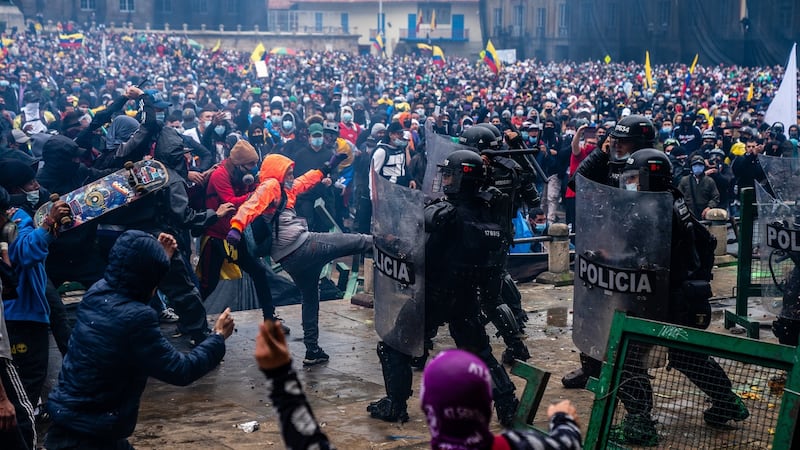The dead include a ninth-grader who went out to protest with his brother; an artist shot in the head as cameras rolled; and a teenager whose mother’s anguished cries of grief – “son, I want to be with you!” – have been shared thousands of times online.
At least 19 people were killed and hundreds more injured during days of protests across Colombia, in which tens of thousands of people have taken to the streets to demonstrate against a tax overhaul meant to fill a pandemic-related fiscal hole.
On Sunday, President Iván Duque announced that he would withdraw the current proposal, and instead seek a new plan, this time borne out of consensus. “The reform is not a whim,” he said, “the reform is a necessity.”
On Monday, the country’s finance minister said he would resign.
But the decisions have done little to quell public anger, and the protests have morphed into a national outcry over rising poverty, unemployment and inequality set off by the arrival of the coronavirus last year.

Latin America, and South America in particular, has been especially pummelled by the virus, and many countries in the region face dire fiscal conditions if reforms are not made.
Duque was among the first to try to address his country’s economic problems, and the public response here does not bode well for other regional leaders, said Sergio Guzmán, the director of the Colombia Risk Analysis, a consultancy.
“This is one of those moments where a key break in society is happening,” he said. “And people are fed up and waking up to the power of the streets.”
Police abuse
The protests have continued, in part, because of anger over what several human rights groups have called a heavy-handed state response in trying to control them. Several instances of police abuse have been captured on video in recent days, including one in which a young protester is seen kicking a police officer on a motorbike. The video shows the officer respond by shooting at the protester as he runs away.
The protester was Marcelo Agredo (17), the ninth-grader who went out to march with his brother. He died soon after, according to his father, Armando Agredo. The death was confirmed by the country’s ombudsman, a government agency that investigates human rights violations.
“You don’t take a person’s life for a kick,” said Agredo (62), a retired taxi driver. “We want justice.”
Amid this anger, the country’s former president, Álvaro Uribe, took to Twitter to say Colombians should support “the right of soldiers and police officers to use their weapons to defend themselves” against “terrorism”. The social media site removed the message shortly after, saying it violated rules “regarding the glorification of violence”.
Duque, a political mentee of Uribe, soon deployed more military forces to the street to quell unrest.
The protests began on Wednesday, and by Monday, at least 18 civilians and one police officer, Jesús Solano, had died, according to the country’s ombudsman. Among the dead was Jesús Flórez (86), who died “apparently from gas inhalation”.
At least 540 police officers have been hurt during the demonstrations, according to the national police, while more than 100 buses have been vandalised or burned. The police said they had also identified nearly 17,000 people who were not complying with public health measures like wearing masks.
The protests come just as the country is experiencing its deadliest moment of the pandemic, and the country has hit record daily death tolls in recent days.
Simmering anger
Guzmán, with Colombia Risk Analysis, said that there was widespread agreement that fiscal reform was needed to keep the country afloat, but that the government had waited too long to rescind the unpopular tax proposal, allowing the anger, frustration and resentment that had been simmering over the last year to boil over.
“Now it’s much more about the way the government has run the country for 2½ years, it’s about the lockdowns, it’s about popular discontent,” he said.
Colombia’s economy shrank 7 per cent last year, while poverty rose from about 36 per cent to nearly 43 per cent of the population, according to numbers released last week.
The tax proposal would have raised tariffs on some everyday goods and services, while keeping in place pandemic-era cash subsidies intended to help struggling people. Ultimately, though, many in the streets said they saw only the tax hikes – and a government that they felt was out of touch with their needs.
"They have pushed us to hunger," said Natalia Arévalo (29), a protester in Bogotá. Arévalo, who sells clothing, said last week that a new lockdown meant to curb the spread of the virus had severely curtailed sales. "Now they want to take the little we have left."
Some of the biggest protests have been in Cali, Colombia's third-largest city. On Sunday, Nicolás Guerrero, a young artist, was among hundreds gathered in a northern part of the city. Suddenly, shots rang out.
A grainy video, livestreamed and watched by many, shows shouting and confusion. Juan Gómez, a 27-year-old lawyer, was there, and watched as Guerrero bled out at his feet.
“It was horrible,” said Gómez. “I have never seen someone die before my eyes.”
“There is no proportionality,” he said of the force being used on the street. “It doesn’t make sense.”
He spoke by phone on Monday. He was angry enough, he said, that he planned to head back to the streets later that day. – New York Times











